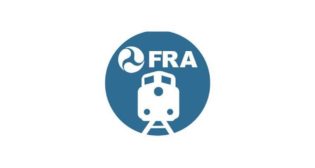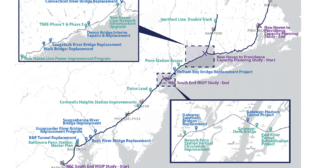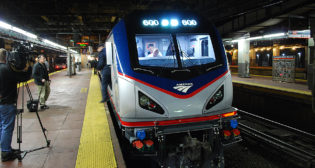
STB Calls ‘Time Out’ in Mobile Slugfest. What’s Next?
Written by David Peter Alan, Contributing Editor
Many have been waiting for the ongoing battle at the Surface Transportation Board (STB) between Amtrak on one side and CSX, Norfolk Southern and the Port of Mobile on the other (Docket No. FD-36496) to resume on Monday, June 13. The issue was how much infrastructure would have to be built before Amtrak can run two daily round trips between New Orleans and Mobile.
The 11-day trial held in April and May before the Board ended with Chair Martin J. Oberman sending both sides back to gather more evidence to support their positions. Then, as Railway Age Executive Editor Marybeth Luczak reported on Friday, June 10, the Board ordered mediation and allowed selected Amtrak employees to gain access to certain information held by CSX and NS about their freight movements that would be pertinent to the case.
While not surprising per se, the Board’s move comes on the eve of the scheduled resumption of the proceedings, even though the agency had denied a similar request by the prospective host railroads to send the case to mediation immediately before the start of the trial in early April. In this commentary, we will take a look at the factors that may have prompted the Board to take this action, and what sort of developments we can reasonably expect to see as the case moves forward.
Highlights From the Decision
The Board issued its five-page decision on June 10. In a nutshell, it allows specific Amtrak employees access to certain otherwise-confidential information from CSX and NS, orders mediation, and directs that supplemental evidence is now due on July 13; 30 days from the previous “due date” of June 13.
The Digest of the Decision (at 1), which is provided for convenience only and not intended to constitute part of the decision itself, is instructive. It says: “This decision modifies the protective order in the proceeding to allow certain Amtrak in-house personnel to access certain materials designated as ‘highly confidential.’ The Board also orders Board-sponsored mediation and extends the deadline for filing supplemental evidence by 30 days, until July 13, 2022.”
Whether the current effort at mediation can actually result in a settlement appears questionable, but it also appears impossible that a settlement could be reached if Amtrak does not have more information about freight movements and operations on CSX and NS, the prospective host railroads.
More Information for Amtrak
In effect, the Board will allow Amtrak to have to have more information from the two freight railroads, but under specific, limited circumstances. The information at issue concerns modeling conducted by CSX and NS using Rail Traffic Controller (RTC), a modeling tool that simulates operations along a rail line, particularly how each move along the segment of railroad in question and the totality of those moves use up available capacity along that line. Much of the trial in April and May concerned RTC studies by the host railroads, and Amtrak complained about alleged deficiencies in the data that they furnished. We reported extensively on each day of the proceedings.
The Board said this in the Decision: “Amtrak says that, because CSXT and NS have designated essentially all the materials related to the 2020 and 2021 RTC studies as ‘highly confidential,’ those materials cannot be viewed by or discussed with anyone from Amtrak. As a result, according to Amtrak, the Amtrak personnel most familiar with the Gulf Coast Corridor and RTC modeling are unable to work on or direct any of the additional RTC modeling discussed by the Board” (at 2).
The Board then modified its April 14 protective order (an order “protecting” a party from having to disclose information it considers confidential to its adversaries during the discovery phase of a trial) in favor of CSX and NS by saying that the modification “is warranted under the circumstances here, as the Board agrees that, without such access, Amtrak will be at a significant disadvantage vis-à-vis CSX and NS in preparing and submitting additional evidence that is responsive to the evidentiary issues raised by the Board” (Id.). Only seven Amtrak employees will be allowed to view the information at issue (listed in note 2). One is Jim Blair, Assistant Vice President for Host Railroads, who was a witness for Amtrak during the proceedings.
The railroads argued that modifying their protective order in that way would up-end Board precedent, but the Board disputed that, noting that the matter is the first case brought under a new statute, and that “the key inquiry is whether Amtrak can operate those trains without impairing unreasonably the freight transportation of the host railroad” (at 3, emphasis in original). The Board explained more fully in a footnote: “The relevant point is not that the carriers could not access each other’s data, but that their jointly retained experts had the ability to communicate with personnel at each carrier to verify and validate RTC modeling assumptions and inputs. It is appropriate given the circumstances of this proceeding that Amtrak be afforded a similar opportunity” (note 5, emphasis in original).
Will the additional information that CSX and NS are now required to give the named Amtrak employees make a difference toward improving the likelihood that the dispute will be settled? We don’t know, because we have no way to tell whether or not it will help Amtrak to understand fully what sort of infrastructure improvements will be needed to allow the operation of the trains that Amtrak wants to run. We can’t even make an educated guess, because the information at issue is still confidential, and the few Amtrak employees who will have it are also required to keep it secret. If that information gives Amtrak enough insight into CSX and NS operations along the relevant lines to help the parties agree on which infrastructure projects are needed (and at what cost), so they can reach agreement, the Board’s modification will have helped resolve the dispute. Otherwise, it will not.
Mediation Coming Soon
In ordinary cases involving civil litigation, some states (and sometimes venues within a state) have rules regarding pre-trial mediation. Some places allow it at the request of the parties or of one party, while others require it.
Mediation is a non-binding process, where a neutral person or a panel of more than one attempts to bring the parties together and help them to work out a compromise that settles their dispute. Mediation is different from arbitration, where a neutral arbitrator or panel of more than one has the authority to impose a settlement on the parties. In essence, the STB acts like an arbitration panel, much as a judge has the authority to make an award in a conventional civil case.
As we previously reported, the prospective host railroads had requested mediation immediately before the start of the trial, and Amtrak did not agree to their request. The Board denied it at the time, largely because the request came on the eve of trial. This time, the host railroads and the Port of Mobile again requested mediation, and Amtrak again did not consent, but the result was different. The Board ordered it (at 5), and the Decision stated that Chairman Oberman “will soon appoint one or more mediators” who will contact the parties and arrange the mediation. The mediation effort will last for 30 days from the first session, and the Board can extend it if the parties agree that they want an extension. Because Amtrak did not consent to mediation, the case will not be held in abeyance, and the supplemental evidence originally due on June 13 is now due on July 13.
What’s Next?
As we reported at the close of the first part of the hearing in May, Oberman complained that the Board did not have enough information, and called on the parties to furnish supplemental evidence by June 13. That deadline has passed, and the new deadline is July 13. It appears clear that Amtrak needs more data in order to feel comfortable with the RTC modeling from CSX and NS that formed most of the subject matter of the trial. It remains to be seen whether the information that CSX and NS have been directed to give Amtrak is actually enough to achieve that result.
The required disclosure must happen soon because the deadline, which is slightly less than one month away at this writing, still stands. That is not much time, although it would be a routine matter for the Board to extend the time if the parties are making progress toward settling their dispute.
The mediation timetable is also nominally 30 days, but it will not begin to run until later, because no mediators have been appointed yet, and they (using the plural form, although there might be only a single mediator) must contact the parties and arrange the first session. The mediation clock will not start to run until that first session, but the 30-day clock for the proceedings has already started running. The Board could issue a new scheduling order later, which would change the timetable for all future events in the case. At the moment, though, time is not on the side that favors the mediation process.
Where Do Things Stand?
It does not appear that the case will be settled easily. It can’t hurt for CSX and NS to give Amtrak enough information to impart a sufficient understanding of freight operations in the region, but it won’t necessarily help, either. The issue concerning the validity of the RTC modeling of NS’s Back Belt in New Orleans and CSX’s New Orleans & Mobile (NO&M) route took up most of the proceeding so far, but the real question before the Board is how much additional infrastructure must be built to accommodate the proposed passenger trains between New Orleans and Mobile. The companion issue is the cost of that infrastructure. In effect, the RTC sub-plot has taken over the entire drama. It’s not exciting content, but that’s the way the case is going.
So far, the long and still-ongoing proceeding has focused on the RTC model almost exclusively, with little mention of the details concerning the infrastructure that will eventually be needed. The parties are far apart on the infrastructure issue, with the host railroads demanding an amount that could cost in excess of $500 million. Amtrak won’t specify a number or an offer beyond a station track at Mobile that could also be used as a layover track. The number from the FRA, which the Southern Rail Commission also supports, was $117 million before the current round of inflation. Will an amount in that ballpark be enough? Maybe for Amtrak, but getting CSX and NS to accept it will be a hard sell for a mediator.
This case has been hard-fought since it began. We have reviewed many of the pleadings, and they reflect hard-line attitudes. A hearing that was originally scheduled to last for four days has now taken just over 10, and there will be more. Our coverage here at Railway Age probably exceeds 50,000 words by five editors and commentators, and there will be more. This is not the sort of case that will settle easily.
To complicate matters further, this is a case of first impression, so it will set precedents that the Board will follow concerning new Amtrak services in the future. Amtrak has proposed dozens of new state-supported lines in its 2035 Connects US Plan. While we don’t know how many of those lines will eventually host Amtrak trains, we do know that every new start under the proposal will require at least some new infrastructure. The precedents that will stem from the present case are vitally important for the STB to determine how much new infrastructure every new Amtrak service will require, and how much that infrastructure will cost. Accordingly, both Amtrak and potential host railroads need to establish a full record in the present case. Without such a record, all the parties would accomplish by settling the current dispute would be to kick the proverbial can down the proverbial road. There seems to be no doubt that the same or similar issues would arise the next time Amtrak and its state partners want to start a new service under the auspices of the 2035 plan, especially since host railroads are taking hard-line positions, not only on the issue of new infrastructure for new services, but also on issues regarding how much Amtrak must reimburse host railroads for their avoidable costs, essentially rent for trackage rights and how to calculate it.
As we recently reported, the STB is also exercising jurisdiction in another Amtrak matter, over operations and how to calculate incentive payments and penalties for on-time-performance, depending on whether it is acceptable or not under current standards. Amtrak and CN are at odds, relating to trains on CN subsidiaries Illinois Central (IC) between Chicago and New Orleans and Grand Trunk Western (GTW) in Michigan, each of which hosts several Amtrak trains. We reported on Amtrak’s side of the story on June 2 and CN’s on June 7. Both sides filed massive submissions in the matter, FD-35748. Amtrak’s ran 497 pages, while CN’s ran 355 pages.
The STB will be busy for a while, establishing precedents for its new jurisdiction regarding infrastructure for new Amtrak routes or services that are slated for restoration after a long absence, and issues regarding Amtrak’s payments to host railroads for use of their tracks. Before those precedents can be established, disputes like the ones currently before the Board must be resolved, which requires a proceeding that strongly resembles litigation.
More to Come
Then there is the highly likely appeal to the D.C. Circuit that the loser will file once the Board issues its final decision in the case, and the petition to the Supreme Court that the loser of the appeal will almost certainly file. That means several more years can elapse before the new precedents can be court-tested and approved, if they are not reversed and sent back to the Board with a requirement that changes be made. Even assuming that the D.C. Circuit affirms the Board’s decision and the Supreme Court denies review, the process could take several years. As we have said before, any delay militates against new trains being established, and the amount of delay that could lie ahead could keep those proposed trains off the rails for years.
So, like many decisions that the Board will render throughout the present case and the CN case, the current ruling will act merely as a procedural wayfinding sign, designed to help move the case toward some sort of a resolution. How soon that resolution will occur is anybody’s guess.
There is one thing we do know: Wwe will have a lot more to report about this case, including commentaries like this one from time to time. We have reported about the towns in Mississippi where the proposed trains would stop, but not about Mobile, where locating the station is an issue in the case. It is also unclear how well the hearing format that is essentially litigation serves the objective of resolving disputes between Amtrak and host railroads before the Board. Beyond questions such as these, there will be more proceedings in the current Mobile slug-out, and we will be here to report them. Stay tuned.

David Peter Alan is one of America’s most experienced transit users and advocates, having ridden every rail transit line in the U.S., and most Canadian systems. He has also ridden the entire Amtrak network and most of the routes on VIA Rail. His advocacy on the national scene focuses on the Rail Users’ Network (RUN), where he has been a Board member since 2005. Locally in New Jersey, he served as Chair of the Lackawanna Coalition for 21 years, and remains a member. He is also a member of NJ Transit’s Senior Citizens and Disabled Residents Transportation Advisory Committee (SCDRTAC). When not writing or traveling, he practices law in the fields of Intellectual Property (Patents, Trademarks and Copyright) and business law. The opinions expressed here are his own.



